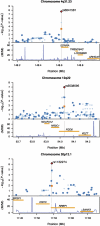Common variant near the endothelin receptor type A (EDNRA) gene is associated with intracranial aneurysm risk
- PMID: 22106312
- PMCID: PMC3241810
- DOI: 10.1073/pnas.1117137108
Common variant near the endothelin receptor type A (EDNRA) gene is associated with intracranial aneurysm risk
Abstract
The pathogenesis of intracranial aneurysm (IA) formation and rupture is complex, with significant contribution from genetic factors. We previously reported genome-wide association studies based on European discovery and Japanese replication cohorts of 5,891 cases and 14,181 controls that identified five disease-related loci. These studies were based on testing replication of genomic regions that contained SNPs with posterior probability of association (PPA) greater than 0.5 in the discovery cohort. To identify additional IA risk loci, we pursued 14 loci with PPAs in the discovery cohort between 0.1 and 0.5. Twenty-five SNPs from these loci were genotyped using two independent Japanese cohorts, and the results from discovery and replication cohorts were combined by meta-analysis. The results demonstrated significant association of IA with rs6841581 on chromosome 4q31.23, immediately 5' of the endothelin receptor type A with P = 2.2 × 10(-8) [odds ratio (OR) = 1.22, PPA = 0.986]. We also observed substantially increased evidence of association for two other regions on chromosomes 12q22 (OR = 1.16, P = 1.1 × 10(-7), PPA = 0.934) and 20p12.1 (OR = 1.20, P = 6.9 × 10(-7), PPA = 0.728). Although endothelin signaling has been hypothesized to play a role in various cardiovascular disorders for over two decades, our results are unique in providing genetic evidence for a significant association with IA and suggest that manipulation of the endothelin pathway may have important implications for the prevention and treatment of IA.
Conflict of interest statement
The authors declare no conflict of interest.
Figures



References
-
- Rinkel GJ, Djibuti M, Algra A, van Gijn J. Prevalence and risk of rupture of intracranial aneurysms: a systematic review. Stroke. 1998;29:251–256. - PubMed
-
- International Study of Unruptured Intracranial Aneurysms Investigators Unruptured intracranial aneurysms—Risk of rupture and risks of surgical intervention. N Engl J Med. 1998;339:1725–1733. - PubMed
-
- Bederson JB, et al. Recommendations for the management of patients with unruptured intracranial aneurysms: A Statement for healthcare professionals from the Stroke Council of the American Heart Association. Stroke. 2000;31:2742–2750. - PubMed
-
- Nahed BV, et al. Genetics of intracranial aneurysms. Neurosurgery. 2007;60:213–225; discussion 225–226. - PubMed
-
- Nixon AM, Gunel M, Sumpio BE. The critical role of hemodynamics in the development of cerebral vascular disease. J Neurosurg. 2010;112:1240–1253. - PubMed
Publication types
MeSH terms
Substances
Grants and funding
LinkOut - more resources
Full Text Sources
Other Literature Sources
Medical

